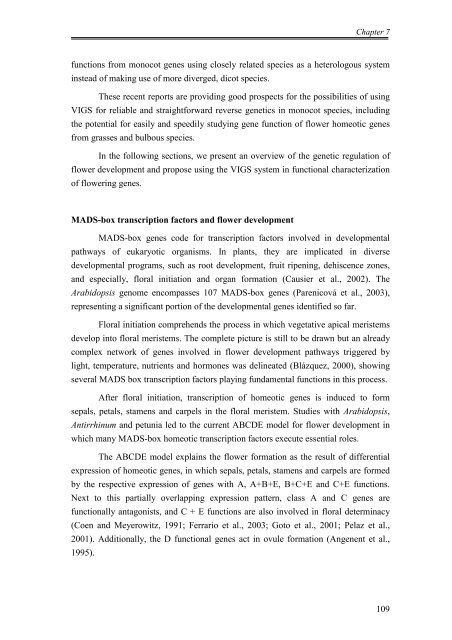Flower development of Lilium longiflorum - The Lilium information ...
Flower development of Lilium longiflorum - The Lilium information ...
Flower development of Lilium longiflorum - The Lilium information ...
You also want an ePaper? Increase the reach of your titles
YUMPU automatically turns print PDFs into web optimized ePapers that Google loves.
Chapter 7<br />
functions from monocot genes using closely related species as a heterologous system<br />
instead <strong>of</strong> making use <strong>of</strong> more diverged, dicot species.<br />
<strong>The</strong>se recent reports are providing good prospects for the possibilities <strong>of</strong> using<br />
VIGS for reliable and straightforward reverse genetics in monocot species, including<br />
the potential for easily and speedily studying gene function <strong>of</strong> flower homeotic genes<br />
from grasses and bulbous species.<br />
In the following sections, we present an overview <strong>of</strong> the genetic regulation <strong>of</strong><br />
flower <strong>development</strong> and propose using the VIGS system in functional characterization<br />
<strong>of</strong> flowering genes.<br />
MADS-box transcription factors and flower <strong>development</strong><br />
MADS-box genes code for transcription factors involved in <strong>development</strong>al<br />
pathways <strong>of</strong> eukaryotic organisms. In plants, they are implicated in diverse<br />
<strong>development</strong>al programs, such as root <strong>development</strong>, fruit ripening, dehiscence zones,<br />
and especially, floral initiation and organ formation (Causier et al., 2002). <strong>The</strong><br />
Arabidopsis genome encompasses 107 MADS-box genes (Parenicová et al., 2003),<br />
representing a significant portion <strong>of</strong> the <strong>development</strong>al genes identified so far.<br />
Floral initiation comprehends the process in which vegetative apical meristems<br />
develop into floral meristems. <strong>The</strong> complete picture is still to be drawn but an already<br />
complex network <strong>of</strong> genes involved in flower <strong>development</strong> pathways triggered by<br />
light, temperature, nutrients and hormones was delineated (Blázquez, 2000), showing<br />
several MADS box transcription factors playing fundamental functions in this process.<br />
After floral initiation, transcription <strong>of</strong> homeotic genes is induced to form<br />
sepals, petals, stamens and carpels in the floral meristem. Studies with Arabidopsis,<br />
Antirrhinum and petunia led to the current ABCDE model for flower <strong>development</strong> in<br />
which many MADS-box homeotic transcription factors execute essential roles.<br />
<strong>The</strong> ABCDE model explains the flower formation as the result <strong>of</strong> differential<br />
expression <strong>of</strong> homeotic genes, in which sepals, petals, stamens and carpels are formed<br />
by the respective expression <strong>of</strong> genes with A, A+B+E, B+C+E and C+E functions.<br />
Next to this partially overlapping expression pattern, class A and C genes are<br />
functionally antagonists, and C + E functions are also involved in floral determinacy<br />
(Coen and Meyerowitz, 1991; Ferrario et al., 2003; Goto et al., 2001; Pelaz et al.,<br />
2001). Additionally, the D functional genes act in ovule formation (Angenent et al.,<br />
1995).<br />
109














